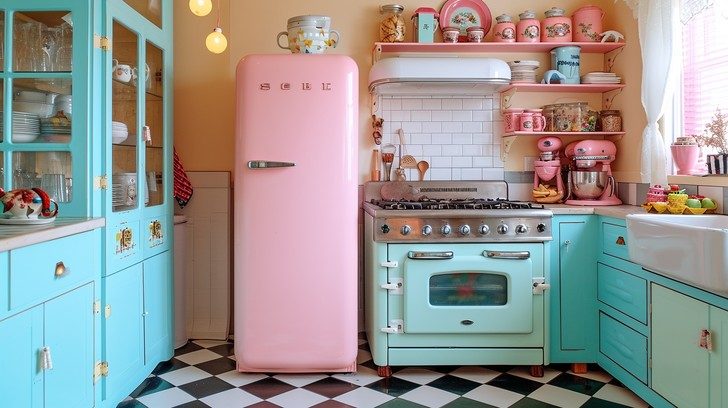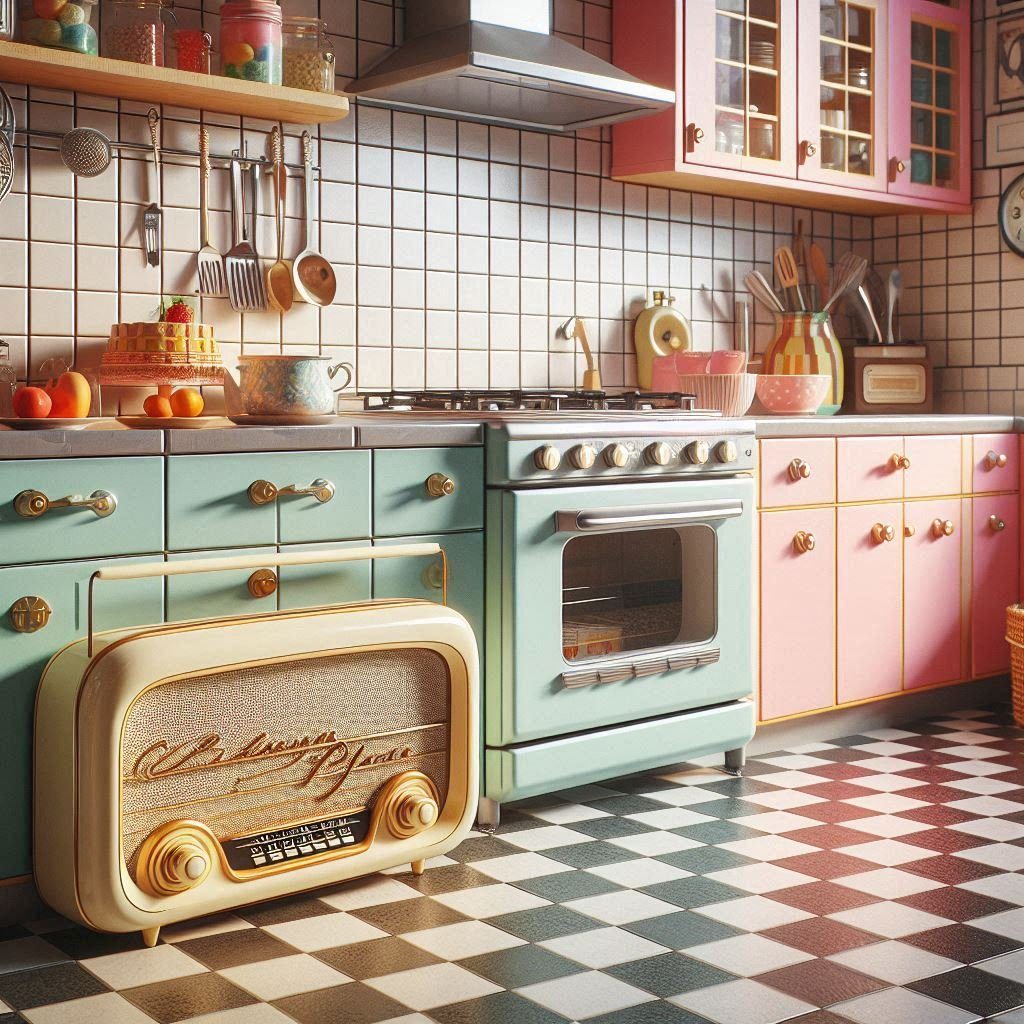The 1950s kitchen was more than just a culinary workspace; it was a quintessential emblem of post-war optimism and technological marvel. This epoch of domestic design represented a kaleidoscopic fusion of functionality, aesthetic exuberance, and unprecedented innovation.
Emerging from the constraints of World War II, mid-century kitchen design became a vibrant canvas where homemakers could express creativity, embrace modern conveniences, and celebrate the burgeoning consumer culture.
1950s Kitchen Ideas
From pastel color palettes to sleek appliances and ingenious storage solutions, these kitchens were not merely rooms but sanctuaries of domestic transformation that reflected the era’s progressive spirit and unbridled enthusiasm for the future.
1. Pastel Color Palettes: Soft Hues of Nostalgia

The 1950s kitchen was a symphony of soft, delightful colors that transformed cooking spaces into cheerful environments. Pastel shades like mint green, buttercup yellow, powder blue, and soft pink dominated the design landscape, creating an atmosphere of lightness and optimism. These gentle hues weren’t just aesthetic choices but psychological statements of hope and renewal following the somber years of World War II.
Homeowners meticulously selected color combinations that reflected personality while maintaining a sense of cohesion. Refrigerators, stoves, and even kitchen accessories came in these enchanting pastel tones, turning everyday appliances into design statements. The color palette was a deliberate departure from the muted, utilitarian designs of the previous decade, symbolizing a newfound sense of joy and possibility.
2. Formica Countertops: The Miracle Material

Formica countertops emerged as the revolutionary material that defined 1950s kitchen aesthetics. These innovative surfaces offered a perfect blend of practicality and style, featuring vibrant patterns and colors that could withstand daily wear and tear. Boasting remarkable durability and easy maintenance, Formica quickly became the go-to choice for middle-class American kitchens.
The material’s versatility allowed for an incredible range of designs, from boomerang patterns to starbursts and atomic-inspired motifs. Homeowners could select from an array of color combinations that reflected their personal taste while enjoying a surface that was both hygienic and resistant to stains. Formica represented the era’s fascination with modern materials and mass production techniques.
3. Chrome and Metallic Accents: Gleaming Modernity

Chrome and metallic finishes were the epitome of 1950s kitchen sophistication. These lustrous elements transformed kitchen spaces into futuristic environments that celebrated industrial design and technological progress. From sleek appliance handles to light fixtures and chair legs, chrome became the defining accent of the decade.
The metallic aesthetic was more than a design choice; it was a statement of optimism and forward-thinking. Manufacturers incorporated chrome into everything from mixer stands to toaster designs, creating a unified look that spoke to the era’s fascination with space-age aesthetics and industrial innovation. These gleaming surfaces reflected not just light, but the boundless possibilities of mid-century American design.
4. Built-in Appliances: Streamlined Efficiency

The 1950s witnessed a revolutionary approach to kitchen design with the introduction of built-in appliances. These integrated solutions transformed kitchen layouts, creating smooth, uninterrupted surfaces that maximized space and enhanced aesthetic appeal. Refrigerators, ovens, and dishwashers were no longer standalone objects but became seamless components of the kitchen’s architectural design.
Manufacturers like General Electric and Westinghouse led the charge in creating appliances that were not just functional but also visually appealing. The built-in trend reflected the era’s obsession with efficiency and modern living, allowing homemakers to create kitchens that were both practical and elegant. These designs represented a significant departure from previous decades’ cluttered kitchen spaces.
Related Guide: 15 Perfect Kitchen Counter Decor Ideas
5. Atomic Age Patterns: Geometric Whimsy

Atomic Age patterns brought unprecedented visual excitement to 1950s kitchen design. Characterized by starbursts, boomerangs, and abstract geometric shapes, these patterns reflected the era’s fascination with science, space exploration, and technological advancement. Wallpapers, curtains, and even linoleum floors embraced these dynamic, energetic designs.
The geometric motifs were more than decorative elements; they represented a cultural zeitgeist of optimism and progress. Designers drew inspiration from scientific imagery, translating complex molecular structures and cosmic phenomena into playful, accessible design languages. These patterns transformed mundane kitchen spaces into vibrant, dynamic environments that celebrated human creativity and technological potential.
6. Breakfast Nooks: Intimate Dining Spaces

Breakfast nooks became iconic features of 1950s kitchen design, offering intimate, comfortable dining areas that promoted family togetherness. typically featuring built-in benches, chrome-and-vinyl tables, and large windows, these spaces were more than eating areas—they were social hubs where families gathered and connected.
The design of breakfast nooks reflected the decade’s emphasis on family values and domestic harmony. Compact yet inviting, these spaces maximized kitchen functionality while creating warm, welcoming environments. Colorful cushions, cheerful tablecloths, and strategically placed lighting transformed these nooks into charming focal points of domestic life.
7. Open Shelving: Functional Display

Open shelving emerged as a practical and aesthetic solution in 1950s kitchen design. Unlike closed cabinets, these shelves allowed homemakers to display colorful dishware, decorative items, and kitchen accessories, turning storage into a design opportunity. Ceramic dishes, colorful mixing bowls, and vintage glassware became part of the room’s visual narrative.
The open shelving trend reflected the era’s desire for transparency and accessibility. It wasn’t just about storage but about celebrating domestic objects as design elements. Carefully curated displays became expressions of personal style, transforming kitchen spaces into personalized, dynamic environments that told stories about the inhabitants.
8. Vinyl Flooring: Practical and Playful

Vinyl flooring revolutionized kitchen design in the 1950s, offering unprecedented combinations of durability, affordability, and visual appeal. Available in an extensive range of colors and patterns, these floors could mimic more expensive materials while providing easy maintenance and exceptional resilience.
Checkerboard patterns, speckled designs, and bold geometric motifs became hallmarks of vinyl flooring. The material’s ability to withstand heavy foot traffic and resist stains made it ideal for busy kitchen environments. Manufacturers continuously innovated, creating floors that were not just functional but also significant design statements.
9. Vintage Appliance Colors: Beyond White

The 1950s saw a dramatic departure from standard white appliances, introducing a spectrum of colors that transformed kitchen aesthetics. Manufacturers began producing refrigerators, stoves, and mixers in pastel and bold hues like turquoise, coral, butter yellow, and mint green.
These colorful appliances were more than functional devices; they were statements of personal style and cultural optimism. Homeowners could now coordinate their kitchen’s color scheme, turning everyday cooking equipment into design elements that reflected individual personality and contemporary design trends.
10. Rounded Edges and Organic Shapes

Mid-century kitchen design embraced rounded edges and organic shapes, moving away from harsh, angular forms. Curved countertops, circular dining tables, and appliances with soft contours created fluid, welcoming spaces that felt simultaneously modern and comfortable.
The emphasis on organic shapes reflected broader design philosophies of the era, which sought to create harmony between human environments and natural forms. These rounded designs suggested movement, grace, and a departure from the rigid, industrial aesthetics of previous decades.
11. Glass Cabinet Doors: Transparency and Style

Glass cabinet doors became popular in 1950s kitchen design, offering a perfect blend of functionality and aesthetic appeal. These transparent doors allowed homeowners to showcase carefully curated dishware collections while maintaining a sense of organization and visual interest.
The trend reflected the era’s desire for openness and accessibility. By making storage spaces visually permeable, designers created kitchen environments that felt more spacious and dynamic. Etched, frosted, and colored glass options provided additional opportunities for personalization.
Related Guide: 14 Inspiring Tiny Kitchen Ideas
12. Pendant Lighting: Sculptural Illumination

Pendant lights emerged as crucial design elements in 1950s kitchens, transforming lighting from a purely functional necessity to a significant aesthetic statement. Featuring geometric shapes, metallic finishes, and innovative materials, these fixtures became sculptural objects that defined spatial character.
Designers experimented with various forms, from classic cone shapes to more abstract, asymmetrical designs. The strategic placement of pendant lights allowed homeowners to create layered, sophisticated lighting schemes that enhanced both functionality and visual appeal.
13. Wall Clocks as Decorative Statements
Wall clocks transcended their timekeeping function in 1950s kitchens, becoming bold decorative statements. Sunburst designs, atomic-inspired shapes, and vibrant colors transformed these practical devices into significant design elements that reflected the era’s artistic sensibilities.
Manufacturers like George Nelson created iconic clock designs that became collector’s items. These timepieces were more than accessories; they were artistic representations of mid-century modern design philosophy, celebrating simplicity, functionality, and aesthetic innovation.
14. Modular Storage Solutions

The 1950s introduced modular storage concepts that maximized kitchen efficiency. Sliding drawers, pull-out shelves, and integrated organizational systems allowed homemakers to create highly personalized, adaptable kitchen spaces that could evolve with changing needs.
These storage solutions reflected the era’s emphasis on scientific organization and ergonomic design. By prioritizing functionality without sacrificing aesthetic appeal, designers created kitchen environments that were both beautiful and supremely practical.
Conclusion
The 1950s kitchen was far more than a mere cooking space—it was a vibrant canvas of cultural expression, technological innovation, and design creativity. These remarkable spaces captured the era’s unbridled optimism, transforming domestic environments into laboratories of style and functionality.
From pastel color palettes to innovative appliances and revolutionary design concepts, mid-century kitchens represented a pivotal moment in architectural and interior design history. They continue to inspire contemporary designers, reminding us that great design is ultimately about creating spaces that are both beautiful and meaningful.

